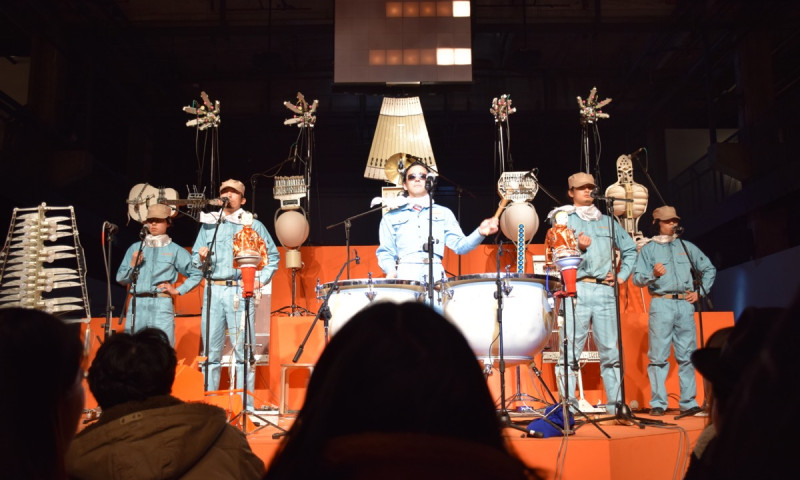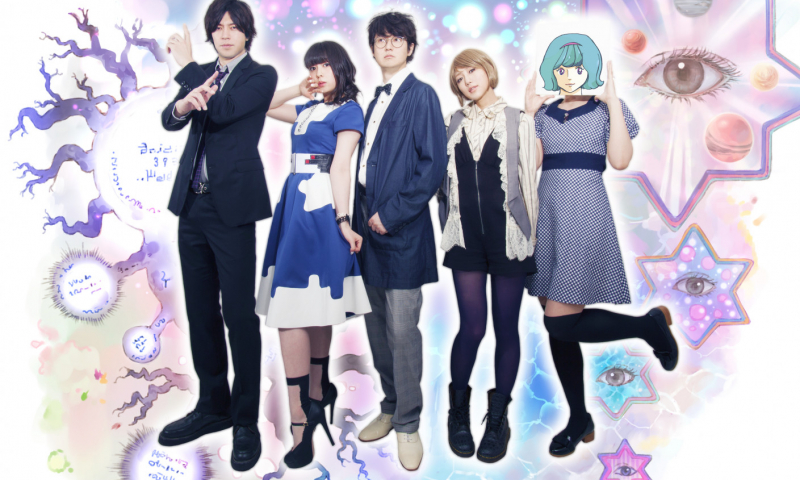
TOKYO CUTTING EDGE CREATORS by Julie Watai #11 featuring Frenesi: The Singer-Songwriting-Animator
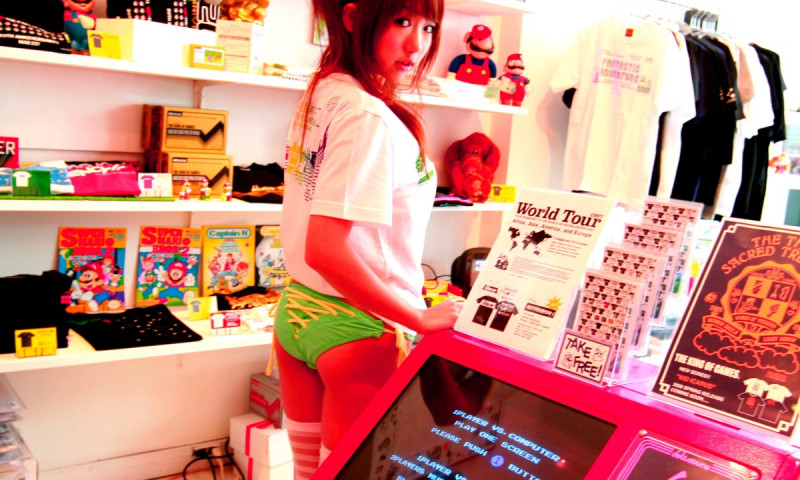
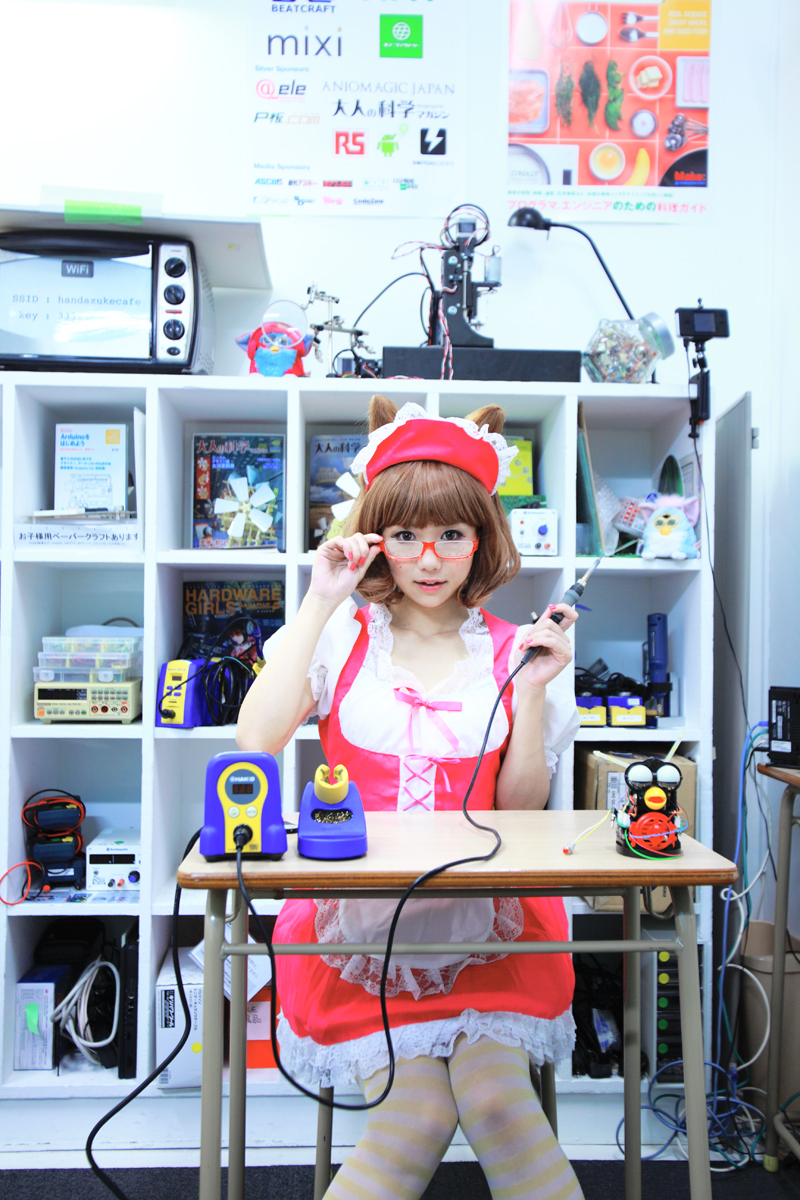
Sponsored Links
TOKYO CUTTING-EDGE CREATORS by Julie Watai is column series, which covers Tokyo’s latest cutting-edge culture! In this series she’ll be interviewing creators that have caught her interest, in order to discover the latest cutting-edge culture in Tokyo. We have interviewed Ai☆Madonna, Junya Suzuki from chloma, Etsuko Ichihara, TORIENA, and Tadashi Shimaya, Nukeme, and Keisuke Nagami from HATRA, and Novmichi Tosa from Maywa Denki.
東京の最先端カルチャーを常に追いかけ続けているJulie Wataiさんの連載『TOKYO CUTTING-EDGE CREATORS by Julie Watai』。この連載では、Julie Wataiが注目するクリエイターとの対談を通じ、新たな東京の最先端カルチャーを発見していきます。初回では愛☆まどんなさん、第2回目ではchloma鈴木淳哉さん、第3回目では市原えつこさん、第4回ではTORIENAさん、第5回では島谷直志さん、第6回ではヌケメさん、第7回ではHATRA長見佳祐さんと、第8回では明和電機土佐信道さんにインタビューを行いました。
For the 9th installment, we’ll be interviewing Tomofumi Yoshida from an art unit “Techno-Shugei Club”.
そして第9回目となる今回は、アートユニット「テクノ手芸部」のよしだともふみさんにお話を伺いました。
Julie::Hello, Tomofumi Yoshida! Long time, no see! Thanks for being here today. To start off, could you tell me a little about what you do in your Techno-Shugei Club?
Julie:よしだともふみさん、こんにちは。お久しぶりです! 本日はよろしくお願いします。
早速なんですが、テクノ手芸部とはどういった活動をしている人たちなのが教えてもらえますか。
Yoshida:Glad to see you again. Techno-Shugei Club is an art unit that combines electronics and high-tech materials that stereotypically considered difficult to work with, with handicrafts that people feel more familiar with, working to spread this new style of craft, or “techno crafting”, all over the world.
よしだ:よろしくお願いします。テクノ手芸部は、難しく思われがちな電子工作やハイテク素材と、暖かみのある手芸を組み合わせた新しいクラフト『テクノ手芸』を世の中に広める活動を行うアートユニットです。
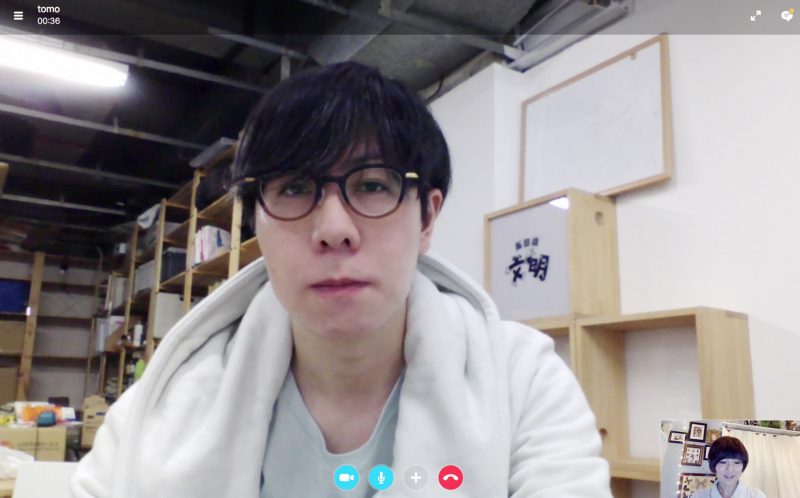
The interview was conducted via Skype. / 対談はSkypeで行われました
Julie:It’s a two-person unit, right?
Julie:2人組のユニットということですよね。
Yoshida:That’s right. The unit consists of Kyoko Kasuya and myself.
よしだ:メンバーは、かすやきょうこと私の2名です。
Julie:Do you have a system for splitting your roles in the unit?
Julie:お二人の役割分担って、決まっていたりしますか?
Yoshida:No, our roles aren’t really defined. One of us might be a little better at something than the other, but that’s it.
よしだ:いえ、役割はとくに定まっていません。得意なことがすこしだけ異なるかな、という感じです。
Julie:Which areas are you better at?
Julie:お二人それぞれの得意分野ってなんでしょうか?
Yoshida:Well, when it comes to personal strengths, I feel like Kyoko is good with software, and I’m good with machines. We each do both, though.
よしだ:そうですね、強いて言えば、かすやさんはソフトウェアに強く、よしだはメカに強いという気はします。でもお互いどっちもやるんですけれど。
Julie:Being a male and female unit, I figured that you’d both have separate roles in the unit, but it turns out I was wrong. Up until this point Techno-Shugei Club has come out with quite a lot of work, but could you tell me about pieces that have been particularly popular?
Julie:男性と女性のユニットなのではっきりと得意分野を分けている印象がありますが、ちょっと意外ですよね。これまでテクノ手芸部はたくさんの作品を発表されていますけど、特に反響が多かった作品を幾つか教えてください。
Yoshida::Kyoko’s Light-up Roe Salmon has a lot of fans!
よしだ:かすやさんが作った『光るイクラのシャケ』はファンが多いです!
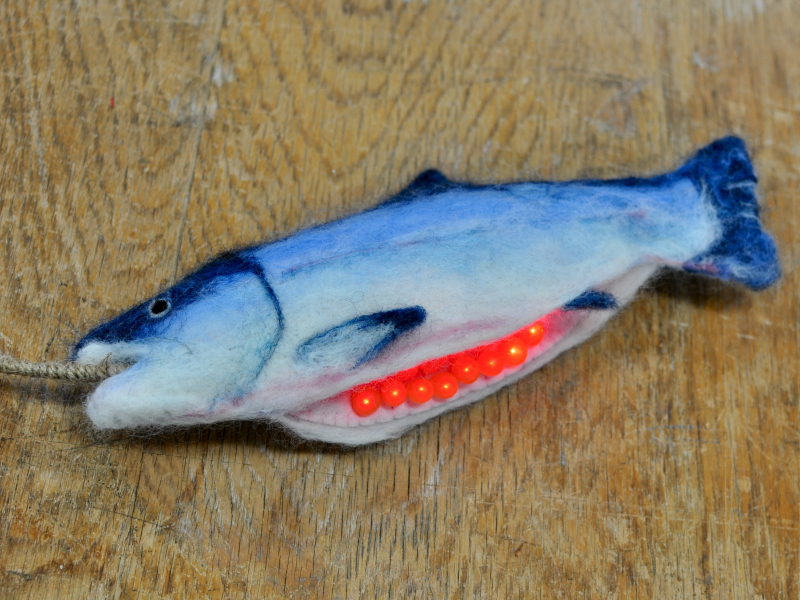
Julie:Oh, I also really like that one!
Julie:あ、私も大好きな作品だ!
Yoshida:We’ve also made many other light-up animals. Our workshop where you can make a light-up brooch of your favorite animal is pretty popular.
よしだ:あと、ほかにも目が光る動物とかをいろいろ作っていて。好きな動物のブローチが作れるワークショップはとりわけ好評です。
Julie:The salmon roe on its stomach lights up with LED lights… But, like, even though there’s a slit in its stomach, there’s a nice balance to it, making it cute.
Julie:お腹に入ったイクラの卵の部分がLEDでピカピカ光る……。でも何だろう、お腹がぱっくり割かれた魚類なのに絶妙なバランスで可愛いんですよ。
Yoshida:The salmon looks delicious, cute, and grotesque all at the same time, which I agree makes it pretty good.
よしだ:シャケは美味しそうで、かわいくて、グロテスクで、あやうくていいですよね。
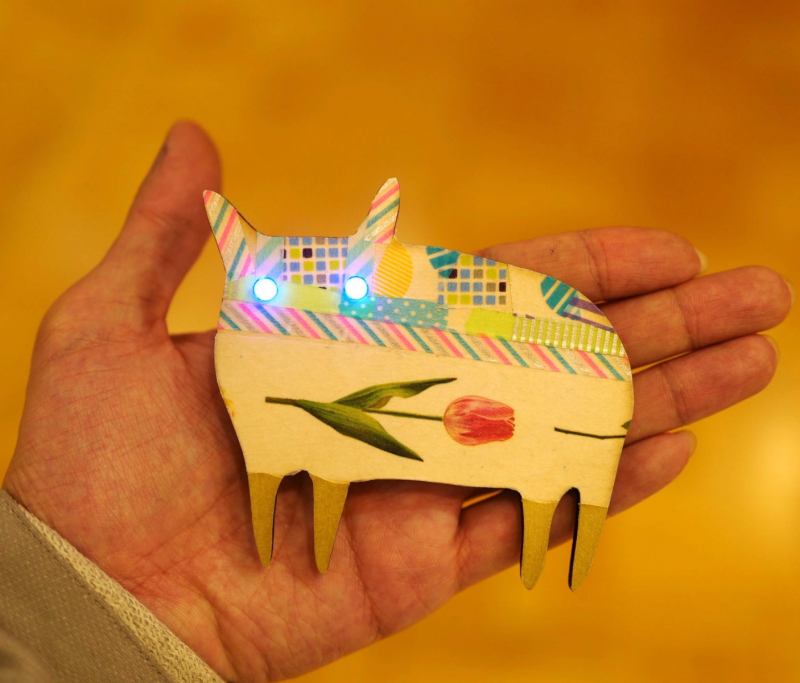
Julie:Wow, this one’s also cute!! It’s an animal brooch with light-up eyes.
Julie:わわ、これも可愛い!! 目が光る動物のブローチ。
Yoshida:When you make the fish out of wool felt like this, it’s a kind of hack for giving it a real skin-like feel. It’s strange but I like it. You can make a lot of different variations of weird animals.
よしだ:魚類を羊毛フェルトでつくるとそもそも肌感覚をハックされる感じというか。奇妙で好きです。
変な動物はいろいろバリエーションをつくりました。
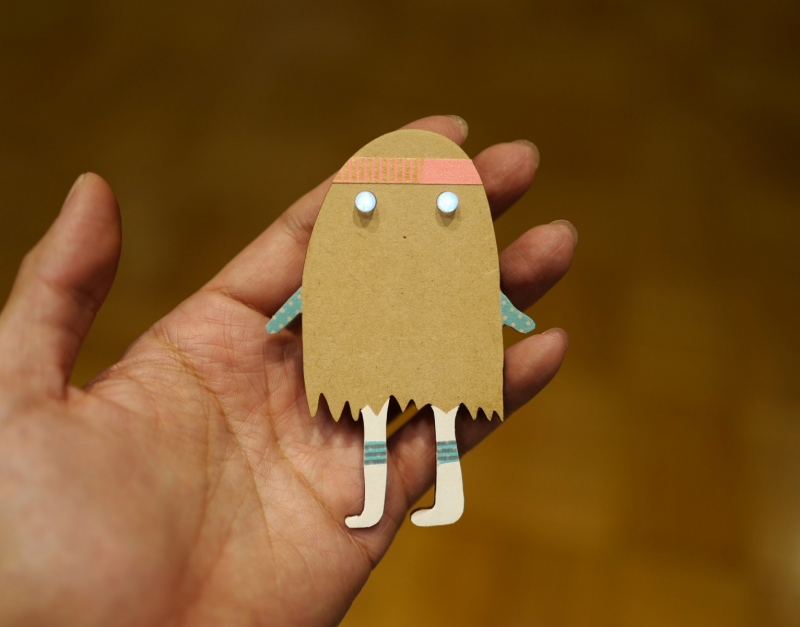
Julie:What’s this one? Is this strange, cute little guy supposed to be… a human?!
Julie:え、なんだ? このへんてこ可愛いのは……。人類!?
Toshifumi:The person who made it isn’t really sure either, but he sure is a stylish little guy.
よしだ:製作者たちもよくわからない、おしゃれな生きものです。
Julie:Yeah, he’s got free sense of style. At a glance, I couldn’t even tell it was an electric piece. This one’s really good!
Julie:うん、確かにゆるくてオシャレです。一見すると電子工作の雰囲気が感じられなくて。すごいです!
Yoshida:There are people who like geeky things, but I feel like even people who don’t normally see the appeal in things like that would see the charm in it!
よしだ:ギークな雰囲気が好きな人はいるんですが、その魅力を感じてこなかった人にも響いたらいいなと思っています!
Julie:Now that you mention it, it does evoke that kind of feminine “Cute!” feeling. The animals at your workshops can be purchased at Hitsuji Antenna, which is Techno-Shugei Club’s online store.
Julie:確かに、今、パッと見て、女性的な感性で「可愛い!」って思いました。ワークショップで作れる動物のブローチなんですが、テクノ手芸部のオンラインストア「ヒツジアンテナ」で購入できますよね。
Yoshida:Thanks for the free advertisement! (laughs)
よしだ:宣伝ありがとうございます(笑)!
Julie:But as far as a physical location goes, you seem to be selling them in front of Akihabara Station on Robot Aisle, which was formerly the site of Radio Store.
Julie:店舗だと秋葉原駅前の旧ラジオストアー跡地にある「ロボットアイル」でも取り扱いがあるそうで。
Yoshida:We also sell them through Village Vanguard’s web shop. However, because we make every one by hand, we’re not able to make large quantities.
よしだ:あとヴィレッジヴァンガードのウェブショップでも販売しております。でも、手作業でひとつひとつ作っているのでなかなかたくさんは作れないんですよね、これ。
Julie:It’s all done by hand! The circuit board is really detailed… I imagine it must be really hard work. I also purchased your Tech Cat Strap at your booth at MakerFaire event the other day. I made it into a choker and I’ve used it in some of my shoots. I’ve gotten lots of complements on it, especially from other women like, “The cat shaped circuit board is so tiny but it’s eyes really shine!” or, “Where did you get it? It’s so cute!”
Julie:手作業だったんだ! 基板とかめっちゃ細かいし……。こりゃ大変な作業ですよね、きっと。私も、先日開催されたMakerFaireのテクノ手芸部のブースで「テク猫ストラップ」を購入しました。チョーカーに付け替えて、撮影などでも時々使わせてもらっているんですけど、すごく褒められますよ。特に女性から反響が多いですね。「猫の形の基板がすごくちっちゃいサイズなのに、目だけがピカピカ光ってる!」「どこで売ってるの? かわいい!」って。
Yoshida:Oh, that makes me happy to hear! We also sell this one on our online store!
よしだ:おお、嬉しいです! これもオンラインストアで売っております!
Julie:It doesn’t seem like your items are lacking girl appeal at all, with all that coming from girls who aren’t in any way involved in geek culture!
Julie:やはり女性の食いつきが半端ないんですよ。それもギークと無関係そうな女子から!
Yoshida:I’m really glad to hear that.
よしだ:それは嬉しいですね。
Julie:The line-ups that appear on the official site and Village Vanguard’s online store are different, aren’t they? I really recommend them both.
Julie:オフィシャルサイトとヴィレッジヴァンガードのオンラインストアでは、またラインナップ違いますね。どっちもおすすめしておきます。
Yoshida:Thanks a lot!
よしだ:ありがとうございます!
Julie:You also published a book in 2010 titled Techno Crafts, didn’t you? In it you provided detailed explanations of a number of Techno-Shugei Club’s pieces, from parts to how to make it. There are usually notes about what’s needed to make an item, but you didn’t stop there and also published the program source code, so I feel like you were really generous with its content…
Julie:「テクノ手芸」というタイトルの書籍を2010年に出版されてますよね。テクノ手芸部作品のいろいろを、部品の解説から詳しい作り方まで紹介していて。普段、作品制作に使っている道具から、実際に使っているプログラムソースコードまで掲載されているという、なんとも太っ腹すぎる内容で……。
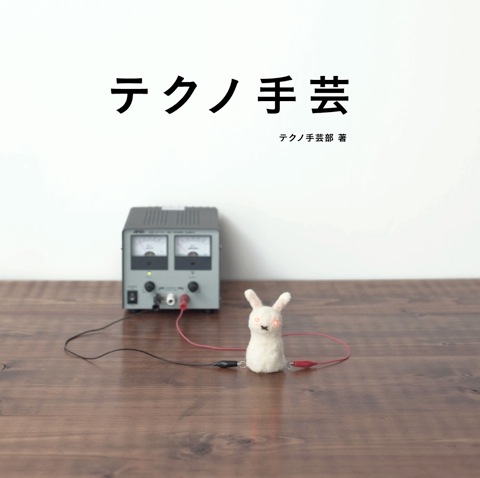
Yoshida:Well, it was published seven years ago, so it’s a little outdated.
よしだ:7年前に出版されたので、ちょっと昔の本ですが。
Julie::That’s true. But since the content itself is so fresh, it doesn’t feel that way. I feel like the real backbone of this book is learning the basics of electrical work through crafting. Actually there seem to be quite a few women that before I knew it, were already using this book to start doing electrical work.
Julie:そうですね。でも、内容が斬新すぎてそんな経っている印象はないんです。手芸感覚でやっているうちに電子工作の基礎知識が身につくというのがこの書籍の「肝」なのかなと思ったのですが。実際にこの本を手にとってみて、いつの間にやら電子工作始めちゃった、という女性もいそう。
Yoshida:There appear to be, and they’ve been kind enough to reach out to me. Additionally, there were cases where research groups were established universities as a result of it, and on the opposite hand, one male engineer maker showed me a circuit he’d made with embroidery.
よしだ:そういう方もいらっしゃって、連絡をいただくこともあります。あと、あの書籍をきっかけに大学で発足した研究会などもあったり、その逆でメーカーの男性エンジニアさんが刺繍で回路を作って見せてくださったこともあります。ありがたいことに反響をたくさんいただいておりまして。
Julie:It seems like we’re already in the age of “Techno Craft Club Kids”. I remember making a comment to you along the lines of, “Wouldn’t it be interesting if electronic parts were sold in craft corners?”
Julie:もう「テクノ手芸部キッズ」が出てきている時代なのですね。以前、よしださんと手芸コーナーで電子工作のパーツとか売り出す時代が来たら面白いねって話していたのを覚えています。
Yoshida:I remember that. It seems like we’re already halfway there.
よしだ:そうなんです。いま色々進めているところです。
Julie:Oh! I totally believe it. There are even accessory makers at Design Festa or on minne selling electronic pieces. Not so long ago, it’s something I wouldn’t have ever imagined.
Julie:おお! そういうのは全然ありだと思うんですよね。デザインフェスタとかminneとかで手作りアクセを作っている人たちも、電子部品を使い出したりしていますし。ちょっと前なら考えられなかった動きで。
Yoshida:It would be great if, including how-tos, there were pre-designed electronic pieces. I think that one great point about Arduino is how well-designed its software and packages are. That’s really important.
よしだ:使い方も含めて、デザインされた電子部品があるといいですよね。Arduinoがすごいのって、ソフトもパッケージも垢抜けていたところかなと思っていて。大事だなぁと。
Julie:Pre-designed electronic pieces… I certainly have to agree. Sometimes I buy random circuit boards for dirt cheap from electronic shop junk boxes, and make accessories from that. But when I do that, the finished product feels totally geeky. While it might be fine to use it as a personal fashion accessory item from time to time, when it comes to something you can wear every day, it’s better if it’s something that was designed to be a decorative item from the very beginning.
Julie:デザインされた電子部品。確かにそうですよね。私はたまに電気屋のジャンク箱から捨て値くらいの適当な基板とかを買って、そこからアクセを作ったりしてるんです。でもそうすると、完成系はギーク感満載で。個性的なファッションの時はそういうのをアクセとして付けていてもいいかもしれないけど、普段使いできるアクセとなると、最初から装飾品としてデザインが整ったものの方が良いですよね。
Yoshida:I’m curious about your perspective when it comes to parts. Does anything spring to mind when you look at stuff like unusual electronic parts or analog synths? Or does the perfect image unravel once you’ve combined it with a cute girl? Which one is it? You don’t ever just take pictures of electronic parts, right?
よしだ:ジュリさんの部品に対する視点も気になっていて。いかにも無骨な電子部品や、アナログシンセなどを見て、そのものにグッと来るのか。それともかわいい女の子と組み合わせたら、さぞよかろうとイメージが広がっているのか。どちらなんでしょう。電子部品だけ写真に撮ることはないですよね?
Julie:I think in my case, since I know a lot of geeks, there’s an element of trying to please them. Like, for instance, If I were going to use a switch part to make a brooch and attach it to an article of clothing, I’d be waiting for someone to remark, “Why’d you put a toggle switch on it?! (laugh)”
Julie:私の場合、周りにギークな知人が多いから、ウケ狙いの要素もありますね。例えばスイッチ部品でブローチを作って服につけて行った場合、「何トグルスイッチ付けてんねん(笑)!」って突っ込まれるの待ち、みたいな。
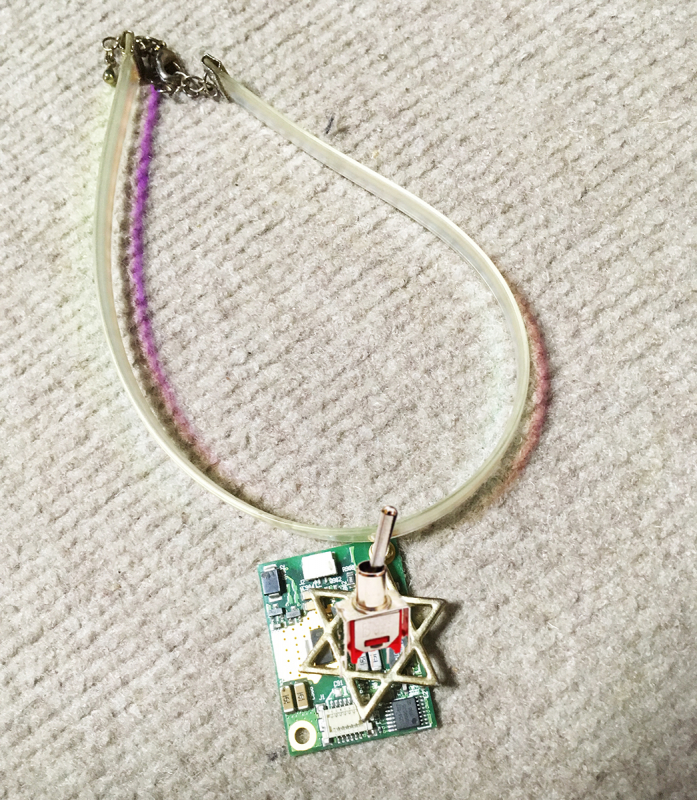
Julie’s handmade toggle switch + circuit board choker/Julieお手製のトグルスイッチ+基板付きチョーカー
Yoshida::I get what you mean!
よしだ:わかります!
Julie:Really?!
Julie:わかっていただけますか!
Yoshida:Putting something where it doesn’t belong is one of the basics of art. And it’s really cool to have a huge switch that you’d normally find inside an airplane’s cockpit on your chest.
よしだ:「あるべきところにない」っていうのは芸術の基本ですよね。飛行機のコックピットにありそうなごついスイッチが胸元にあったりしたらやっぱりかっこいいし。
Julie:Strangeness hidden in everyday life is interesting. When I incorporate electronic parts into my photography work, there are times when I want it to come out SF (science fiction)-like. I like the kind of women who come out of worlds like Ghost in the Shell and Appleseed.
Julie:日常に潜む違和感って面白いですよね。写真の作品に電子部品を取り入れるときは、なんとなくSFっぽいイメージが欲しい時だったり。私、攻殻機動隊とかアップルシードの世界に出てくる女性が好きで。
Yoshida:I see. When it comes to that sense of something being out of place, or say, an elevation difference, it’s important to measure just how out of place it is, so the material requires a discerning eye. Oh, and sorry for giving you a question instead!
よしだ:なるほど。その違和感って、標高差というか、あるべきところじゃない度の大きさが重要なので、素材に対する目利きが要求されそうですね。なんかこちらから質問しちゃってスイマセン!
Julie:Don’t worry about it! I’m glad you asked. The ability to make it where others don’t feel any elevation difference in female portraits really packs a punch. Just on its own, the female image really opens up a lot of doors to different genres. For example, if there was an idol group that sang in a genre of certain music fanatics, many fans would first get into that genre based on the idols’ looks (female image), and from there it’s totally plausible they’d really get into children’s music fanatic-like musical genre. So it’s not the material that’s the discerning factor, but the woman. Naturally if the female model isn’t interested in the subject herself, you won’t be able to get a good expression.
Julie:いえいえ。よしださんに質問してもらって恐縮です。女性のポートレートってその標高差を感じさせないだけの強さ、パンチ力があるんですよ。女性像って、それだけで多様なジャンルへの入り口が開かれるんじゃないかなって。例えばマニアックな音楽ジャンルの曲を歌うアイドルグループがいたとして、多くのファンの人はまずはアイドルのルックス(女性像)とかが入り口だったりして、そこからその子達が歌うマニアックな音楽ジャンルにはまったりすることとかも全然あり得ると思うんです。だから、目利きして選ぶのは機材ではなくて女性の方だったりして。やっぱりモデルの女性自身がそういう題材を面白がってくれないと、いい表情は撮れないんで。
But getting back to the topic at hand, I wonder if many of the participants in Techno-Shugei Club’s periodic workshops are people who know of you through your books or the internet.
話は戻りますが、テクノ手芸部さんが定期的に開催しているワークショップに参加される方々は、書籍やインターネットで知ったという参加者が多いんでしょうか。
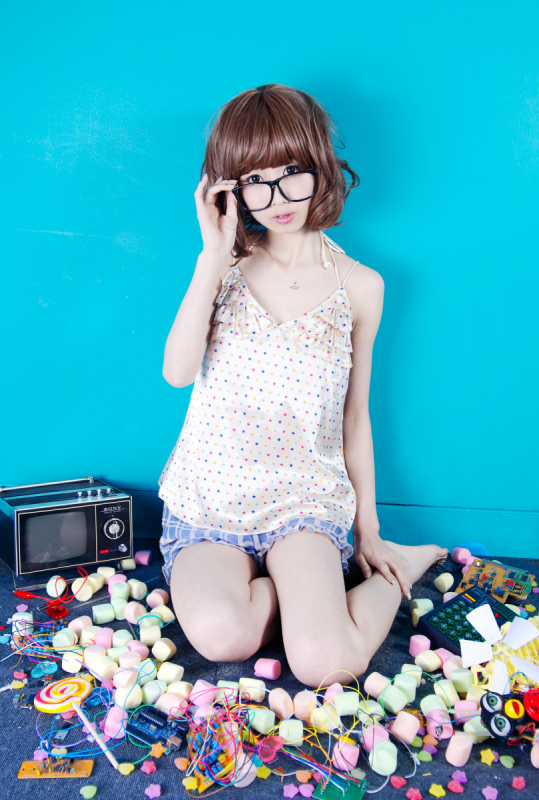
Photo:Julie Watai, Model:Itokutora, Location:Handazuke Cafe / 撮影:Julie Watai、モデル:いとくとら、撮影協力:はんだづけカフェ
Yoshida:No, I doesn’t feel like there are many people who follow that pattern. The workshops are held at a lot of different places, and the organizers at each venue are also different, like at a store or a school. So in that way, there are many instances where the organizer already has a group of customers. There’s a lot of cases like, “The workshop here last time was really interesting, so I decided to come to the one today, too.” It’s fun to see first timers get suddenly thrown into techno crafting. After all, it’s kind of peculiar.
よしだ:いえ、そういう経路は感覚としてはそれほど多くない気がしています。ワークショップはいろいろな場所で開催していて、会場ごとに違う主催者さんが企画しているんですね。お店とか学校とかで。そうすると、その時々の主催者さんの固定客が既にいることが多いんです。「ここで行われているワークショップはいつも面白いので今日も来ました」みたいな感じです。そういう一見さんにテクノ手芸をぶっ込むのが面白いです。やっぱりちょっと特殊なので。
Julie:You’re right. It must have an impact on participants who don’t come in knowing a lot of details about it. I’m sure they go home feeling satisfied, though. You also do workshops aimed at children, right?
Julie: そうですね。偶然に内容を深く知らずに参加した方にはインパクトがありますよね。でも絶対満足して帰るだろうなあ。確かお子さん向けにもやってましたよね?
Yoshida:I do. The majority of those who participated in the ones for MakerFaire and the like were small children. But I think it’s difficult to have that much of an influence on first timers and children with just a one-time encounter. We have to work on building more of a fanbase. In order to do that, I think we should improve the detail quality. I also think the method of distributing information is important. I think there’s a lot of room for improvement in those areas.
よしだ:子ども向けの内容もやっています。MakerFaireなどに参加されるのは大半が小さい子ども達ですね。ただやっぱり、一見さんや子どもに響くような、いわば出会い頭芸だけではきついなと思っていて。ちゃんとファンを作っていかないといけないですし。そのためには細かいところの質をあげていかないとなぁと思っています。情報発信の仕方も大事ですよね。そこは改善の余地があるかなと思っています。
Julie:I think Techno-Shugei Club’s concept is easy to understand and that there are many fans of the items you make. I wouldn’t surprise me to see you get even more popular. Like, I feel like they are cute and fun enough to appeal to junior high and high school girls. Around the same time you published your book, more people started coming to MakerFaire, and even now, I personally feel like the tides have changed a bit.
Julie:テクノ手芸部のコンセプトはだいぶ伝わりやすくて、製品のファンもたくさん居ると思いますけれども。もっと人気が上がってもおかしくないんじゃないかな。例えば女子中高生にも響く可愛さや面白さだと思いますし。この書籍を出版されたあたりの時期って、MakerFaireにも人が増えて、今までとちょっと流れが変わってきた時期なんじゃないかなって個人的に思うんですが。
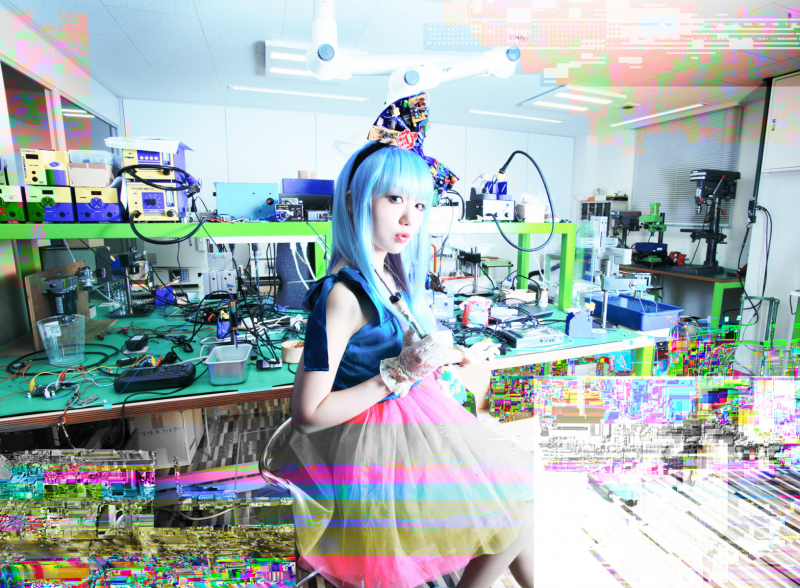
Photo,Model:Julie Watai, Location:HAKKO Corporation / 撮影、モデル:Julie Watai、撮影協力:HAKKO Corporation
Yoshida:I agree. I think a lot of change was happening then. It was around that time that our production space started increasing. I think that’s when everyone started thinking about how to get more ordinary people involved.
よしだ:そうですね。大きく変わっていた時期だと思います。ものづくりのスペースが増え始めた頃ですよね。
普通のひとたちをどうやって巻き込むか、みんな考え始めた頃だと思います。
Julie::MakerFaire was being introduced in the news on TV and in magazines, and I remember feeling a little excited. Before you became a company, did you have any plans of entrepreneurship?
Julie:MakerFaireがテレビのニュースや雑誌で紹介されたりして、あの時はちょっとワクワクしてました。その後、テクノ手芸部は2014年に法人化して株式会社オブシープになりましたね。法人化以前から起業の構想があったのでしょうか。
Yoshida:Yes, we did have plans to. I first felt like it was a necessity around 2010. But, I think its establishment occurred unexpectedly.
よしだ:そうですね。構想はありました。ニーズがありそうな気配は2010年くらいから感じていましたから。ただ、設立のタイミングはたまたまだったと思います。
Julie:I see. So you’d been thinking about it for quite some time. Could you tell me more about how where the company name originated from?
Julie:なるほど。結構前からお考えはあったんですね。社名の由来、教えてもらえますか?
Yoshida:We were using wool felt, and also because I like sheep. There’s also a scientific image associated with it, like with clone sheep. Originally, I also like the unusualness of adding the word “of” to it. It gives it the meaning of “sheep’s (something)”, meaning anything can go there.
よしだ:羊毛フェルトを使ったりしていて。羊が好きなので。クローンヒツジとか、ちょっとサイエンスなイメージもありますし。最初にofが付くのは変則的で好きです。ひつじの◯◯という、なんでも入りそうな名前で。
Julie:Electric Sheep does have an SF ring to it. I see.
Julie:電気羊とか、SFの香りもします。なるほど。
Yoshida:It does.
よしだ:そうそう。
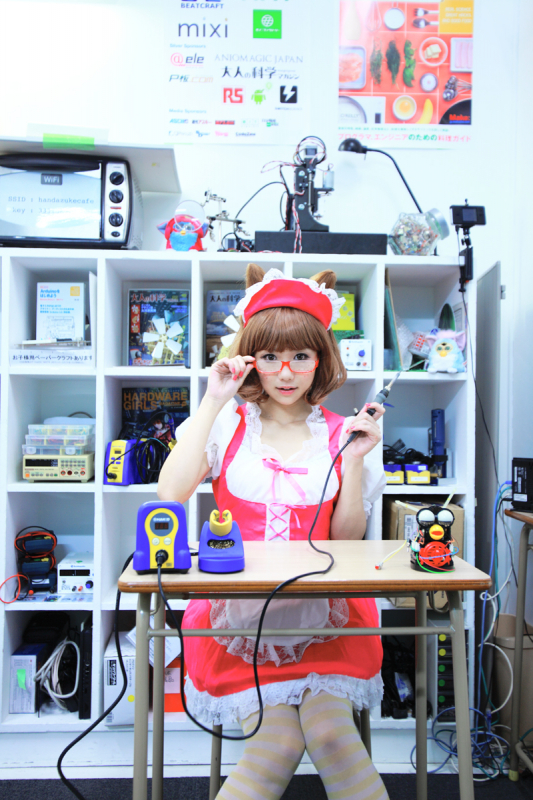
Photo, Model:Julie Watai, Location:Handazuke Cafe / 撮影、モデル:Julie Watai、撮影協力:はんだづけカフェ
Julie:Did your activities change after you established your company?
Julie:法人化してから活動内容が変わってきたりしました?
Yoshida:I was able to take on work that wasn’t available to non-company entities; the type of work that involves a lot of money and people. However, I don’t the basic direction or resolve changed any. I made a company so that I could have an environment that would make it easy to make the kind of things I want to create, and I don’t feel like it’s necessary to change what I want to make to fit that.
よしだ:法人でないと受けられないようなお仕事も受けられるようになりました。お金や人がたくさん関わるようなお仕事です。でも基本的な方向性や意識はあまり変わっていないと思います。作りたいものを作りやすい環境にするために法人化したのですが、その枠に合わせて作りたいものを変えていく必要はないかな、と思っています。
Julie:Broadening the scale of production is a goal for many creators and artists.
Julie:制作の規模が大きくなる事は、クリエーターやアーティストにとっては目標とするところでもありますね。
Yoshida:I think it’s a difficult position to be in. Apart from having the skill to produce things, you also have enough skill to run a business.
よしだ:難しいところだと思います。制作する才能とは別に商いをまわす才能が必要ですよね。
Julie:That’s just it, isn’t it? I really respect people who can do both.
Julie:そう、それなんですよね。それができている人は本当に尊敬します。
Yoshida:People who can do that really are incredible. Not many can.
よしだ:すごいですよね。なかなかできないです。
Julie:Is there an area you want to try delving into in the future?
Julie:よしださんが今後やってみたい分野ってありますか?
Yoshida:I’d like to make more progress with our produce development. I’m thinking something people can buy where those who are interested in he concept can easily get involved.
よしだ:やはり、もうすこし商品開発を進めたいですね。コンセプトに興味を持ってくれた人が、簡単に参加できるのって購入なのかなと思っているので。具体的には教材やキットなどの売り物ですね。
Julie:I’d like that, too!
Julie:それは私も欲しい!
Toshifumi:When people ask me, “Where do you sell them?” it’s difficult for me to answer. It’s like, well… actually we don’t. So from now on, we’ll start selling them!
よしだ:どこで売ってるの?って言われると辛いのです。いや、売ってはいないんだけど・・・みたいな。これからは売ります!
Julie:Ladies and gentlemen, you heard it here first! (laughs) As a fan of Techno-Shugei Club myself, I’m looking forward to what items you come out with in the future.
Julie:お、みなさん、この場で言い切ってもらいました(笑)。テクノ手芸部の一ファンとしても今後のグッズ展開も楽しみに待っています。
Toshifumi:We’ll do our best!
よしだ:がんばります!

Photo:Julie Watai, Model:Mariko, Location:Handazuke Cafe / 撮影:Julie Watai、モデル:Mariko、撮影協力:はんだづけカフェ
After the Interview/対談を終えて
Whenever I’m making electronic pieces, I always think that the most important characteristic of this genre is the outside part that you wrap the circuit in. Or what I want to say is, that even though you gain more knowledge and skill the more you work with electronics, there’s a tendency to rapidly lean toward making things that are “efficient”. But if I really want to make something separate from the part’s intended use, I go back and start again from the beginning and think about what I want to make using that circuit. Or there are times that, to start off, I have something I want to make and then I think about whether or not I can realize it through using electronic technology.
電子工作での物作りをしている時に常々思うのが、もしかするとこのジャンルで大切なポイントって「回路」を包む「外側」かもしれないって事。何が言いたいかと言うと、電子工作をやっていて知識や技術がついてくるのに伴って作るものもどんどん「性能寄り」になってくる傾向がある。でもパーツの元の機能云々ではなく何を作りたいか原点回帰して突き詰めて行くと、その電子回路を使って自分は何を作りたいのかって考えるようになる。まず最初に「作りたいもの」があって、それを実現するための技術としての電子技術だったりする場合もあるのかなと。
Despite not using the part’s original functionality as a base, what Techno-Shugei Club does falls into neither category and is simply amazing. They’ve create a loose outline of a character with exceptional balance that appeals to girls, and an electronic circuit with such a cute design that people are drawn into wanting their own. Because I’d always viewed these things as being distant from everyday life, suddenly being switched on to them feels strange and also quite exciting, which is why I think they attract so many female fans.
テクノ手芸部がやっている事というのはそのどちらも揃わないとあり得ない。女性の琴線に触れる絶妙なバランス感のゆるキャラだったり、物欲を刺激する可愛すぎるデザインの電子基板。これまであまりに日常と遠い位置にあるため意識した事もなかった「スイッチ」を押される奇妙な違和感は十分に刺激的で、それゆえに沢山の女性ファンを魅了しているのだと思う。
Related Links
Techno-Shugei Club Official site:http://techno-shugei.com/
Tomofumi Yoshida Twitter:https://twitter.com/tomo370
Techno-Shugei Club Event Information
テクノ手芸部出演情報
August 5th & 6th, MakerFaireTokyo Exhibition
8/5、6「MakerFaireTokyo」出展
August 28th, Daikanyama Teens’ Creative Art School
8/28 代官山ティーンズ・クリエイティブ アートスクール
Sponsored Links

On a Date with my Girlfriend! Japanese Twitter Trend Makes Your Dreams Come True
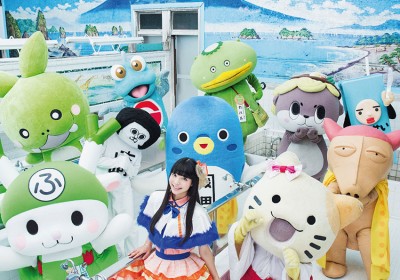
Yurukyara Boom: Cute and Wierd Mascot Characters Taking Over Japan


